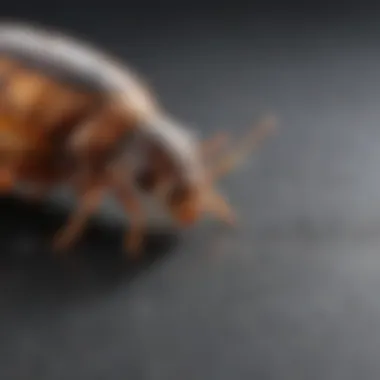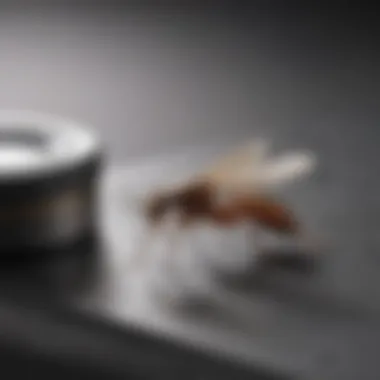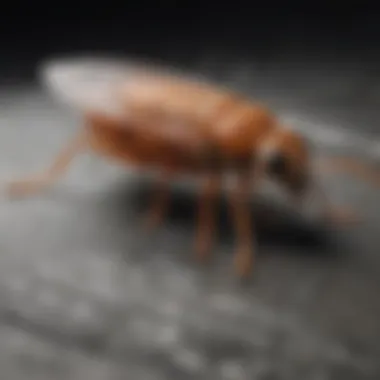RX for Fleas and Fleabusters: An Effective Guide


Intro
Flea control is not merely a homeowner's concern; it is both a necessity and a challenge. The presence of fleas can lead to discomfort, irritations, and health issues for pets and humans alike. Understanding the various pest control solutions available is vital for effective management. This article will examine two prominent pest solutions: RX for Fleas and Fleabusters. By dissecting their components, effectiveness, and application methods, we aim to provide a well-rounded perspective on effective flea control strategies. Our discussion will also consider safety, responsible use, and the ecological impact of these products.
Understanding Pests
Definition of Pests
Pests are organisms that can cause harm to humans, their property, and their pets. Fleas are small, wingless insects that thrive on the blood of mammals. They reproduce rapidly, leading to infestations that can affect entire households. Understanding their biology makes it easier to tackle them effectively.
Importance of Pest Identification
Identifying pests is crucial for selecting suitable control methods. Fleas can often resemble other small insects, and misidentification may lead to improper treatment. By recognizing fleas and understanding their habits, homeowners can better target their pest control efforts.
Prevention Techniques
Home and Garden Preventative Measures
Tackling pests begins with prevention. Here are some effective methods:
- Regular Cleaning: Vacuuming carpets and upholstery removes fleas and eggs.
- Pet Care: Ensure pets are treated with flea medications regularly.
- Physical Barriers: Use screens on windows to keep pests outside.
Seasonal Prevention Tips
Certain seasons bring heightened risks of flea infestations. To be proactive, consider these strategies:
- Winter Preparations: Inspect pets after they return indoors. Cold weather does not kill fleas but may push them indoors.
- Warm Weather Vigilance: During summer, routinely check and treat outdoor areas, such as gardens and patios.
Eco-Friendly Pest Control Solutions
Overview of Sustainable Practices
Sustainability should always be a consideration in pest management. Many methods can reduce pharmaceutical reliance while effectively managing flea populations. Some eco-friendly practices include:
- Traps: Use flea traps that catch fleas without chemicals.
- Beneficial Insects: Introduce ladybugs or parasitic wasps that naturally control flea populations.
Natural Remedies and Their Effectiveness
There are various natural remedies promoted for flea control. While some have limited effectiveness, others may aid in a more integrated approach:
- Diatomaceous Earth: This powdery substance disrupts the flea's exoskeleton, leading to dehydration and death.
- Essential Oils: Oils like lavender and peppermint can repel fleas. However, use caution as some are toxic to pets when concentrated.
Effective flea control combines vigilance and knowledge of various methods. Homeowners are encouraged to adopt a proactive approach by combining both chemical and natural solutions.
Intro to Flea Control
Effective flea control is crucial for maintaining a healthy living environment, especially in homes with pets. Fleas are not just a nuisance; they can pose health risks to both animals and humans. They can provoke allergic reactions, transmit diseases, and lead to discomfort. Therefore, understanding how to manage flea infestations is essential. This section provides insights into the problem fleas present and establishes a framework for discussing methods of control.
Understanding the Flea Problem
Fleas are small, wingless insects that feed on the blood of mammals and birds. The females can lay hundreds of eggs in their lifetime, making it easy for populations to swell rapidly. A flea problem can escalate quickly, resulting in significant health issues for pets due to constant scratching and irritation. Moreover, infected animals can transfer fleas to humans, creating additional concerns in households.
In many environments, fleas find ideal conditions for reproduction. Warm climates and humid settings enhance their life cycle and encourage growth. Therefore, addressing a flea problem requires timely intervention and understanding of flea behavior and lifecycle.
Common Flea Species
There are several species of fleas, but two are the most common in domestic settings: the Cat Flea, Ctenocephalides felis, and the Dog Flea, Ctenocephalides canis. Both species readily feed on humans and any available mammalian host.
- Cat Flea (Ctenocephalides felis): This species accounts for the majority of flea infestations. It is highly adaptable and can thrive in various environments.
- Dog Flea (Ctenocephalides canis): Less common than the Cat Flea, it predominantly infests dogs but can also feed on cats and humans.


Other flea species, like the Rat Flea (Xenopsylla cheopis), may be found in specific situations but are less likely to impact pet owners directly. Recognizing these species can assist in implementing specific control measures appropriate to the infestation. By understanding the nuances and habits of these fleas, household owners can better anticipate and mitigate infestations.
Overview of RX for Fleas
In discussing flea control, understanding RX for Fleas is essential. This product offers a targeted approach designed to address flea infestations effectively. It combines science with user-friendly solutions, making it suitable for both homeowners and pet owners. The focus is primarily on the active ingredients and their functions, which directly impact how successfully fleas are eliminated from a given environment.
RX for Fleas claims a multifaceted approach to rodent control, utilizing specific compounds known for their efficacy. This understanding helps users make informed decisions regarding flea management. Recognizing the active ingredients allows for optimization of flea control strategies, balancing safety for pets and humans with effectiveness against pests.
Active Ingredients and Their Functions
The active ingredients in RX for Fleas are the foundation of its effectiveness. Typically, these compounds include Fipronil and Imidacloprid, both of which target the nervous system of fleas, leading to their swift extermination.
- Fipronil works by disrupting the transmission of impulses in the flea’s nervous system, effectively paralyzing and killing it. This ingredient is particularly noted for its persistence, offering protection for several weeks after application.
- Imidacloprid, on the other hand, is a neonicotinoid that mimics nicotine’s effects in insects. It binds to certain receptors in the flea's nervous system, causing over-stimulation and eventually death. This compound acts rapidly, making it suitable for immediate flea problems.
Collectively, these ingredients make RX for Fleas a broad-spectrum product, effective against adult fleas as well as blocking their life cycle by targeting larvae and eggs in certain formulations.
Application Methods
Proper application of RX for Fleas is critical to its success. Users are typically advised to follow a few key methods to ensure maximum efficacy.
- Spot Treatment: Apply directly to the skin of pets, focusing on areas where fleas are likely to linger. This method ensures that the active ingredients are concentrated in the areas where they are needed most.
- Spray Application: For home environments, RX for Fleas often comes in a spray format. Applying this to carpets, bedding, and pet areas helps to create a protective barrier, discouraging any resurgence of flea populations.
- Systemic Application: Some formulations may be administered orally, allowing the active ingredients to circulate through the pet's system. This approach can provide a dual action by killing fleas on contact and those that bite the treated animal.
"Effective application techniques are as crucial as the product itself in achieving lasting flea control."
In summary, RX for Fleas effectively utilizes well-selected active ingredients in a variety of application methods that cater to different settings and user needs. Understanding these aspects promotes an effective flea control strategy, essential for maintaining a flea-free home.
Examining Fleabusters
Fleabusters have emerged as a significant tool in the arena of flea control. This section examines their unique characteristics and their vital role in pest management. Understanding Fleabusters can equip homeowners with the necessary knowledge to effectively manage flea issues. By exploring the composition and usage of Fleabusters, we outline their efficacy and safe application, making it easier for house owners to make informed choices.
Composition and Effectiveness
Fleabusters typically contain a blend of active ingredients that target flea adults and eggs. Some of the primary ingredients include diatomaceous earth and silica gel. These substances work by desiccating the exoskeletons of fleas, leading to dehydration and death.
In addition to their physical action, Fleabusters often contain insect growth regulators (IGRs). These compounds disrupt the developmental process of fleas, preventing larvae from maturing into adults. The integration of IGRs can enhance overall effectiveness, helping to ensure a more comprehensive treatment compared to traditional methods.
The effectiveness of Fleabusters can be observed in various settings, from homes with pets to areas prone to flea infestations. Research indicates that when applied correctly, these products can dramatically reduce flea populations within a short timeframe.
"Using Fleabusters that combine physical and chemical controls can result in a quicker and more effective flea management strategy."
Usage Directions
Using Fleabusters properly is crucial for achieving the desired results. The following steps outline how to effectively apply these products:
- Initial Cleaning: Before application, thoroughly vacuum all areas, paying close attention to pet bedding, carpets, and upholstered furniture. This removes existing fleas and prepares the area for treatment.
- Application: Spread the Fleabusters product evenly across the affected areas. It is important to follow the manufacturer's instructions concerning dosage and application technique.
- Post-application Care: After treating the area, limit foot traffic to allow the product to settle. Wait for the specified duration before vacuuming again. This duration ensures the active ingredients have time to work effectively.
- Regular Monitoring: Continually monitor for signs of flea re-infestation. If fleas persist, reapply as directed or consult a pest control professional for further assistance.
Implementing these instructions maximizes the potential of Fleabusters to manage flea populations effectively. By being diligent in application, homeowners can create an environment that is less hospitable to fleas.
Comparative Analysis of RX for Fleas and Fleabusters
The comparative analysis of RX for Fleas and Fleabusters serves as a critical evaluation point in this article. Understanding the differences and similarities between these two flea control methods is essential. Both products offer unique benefits and have specific considerations for effective use. Homeowners must grasp these dynamics to select the best approach for their situations.
Efficacy in Different Environments
The efficacy of RX for Fleas and Fleabusters can vary significantly based on the environments in which they are applied. RX for Fleas is often more suitable for controlled indoor spaces. It acts rapidly upon contact, effectively killing fleas in various life stages. This product is ideal for households with pets that frequently roam indoors, helping to prevent reinfestation.
Fleabusters, on the other hand, shines in outdoor settings. It is designed to impact the flea population in yards and gardens. This broad application makes it an excellent choice for homes with expansive outdoor areas. Both products have been tested in real-world scenarios, showcasing their strengths in different contexts. This targeted use can lead to more successful flea management strategies.
"Understanding where each product works best allows homeowners to develop a tailored approach to flea control."


The effectiveness of either solution can be contingent on various factors. These include humidity levels, temperature, and the overall density of flea populations. A thorough evaluation of these environmental conditions will dictate the best approach to use, ensuring that the selected method yields optimal results.
Cost Effectiveness
Cost effectiveness is a vital component in the decision-making process for homeowners facing flea infestations. RX for Fleas typically comes at a lower initial cost per treatment, making it appealing for those looking to manage smaller infestations. It is also often easier to find, widely available at numerous retailers. However, while the upfront price may lure consumers, the long-term effectiveness must also be considered.
Fleabusters presents a different price structure, as its comprehensive coverage can lead to a higher initial investment. Yet, this can balance out over time due to its prolonged impact on flea populations, especially in external environments. If a flea problem extends beyond the internal spaces of the home, investing in Fleabusters might yield better financial sense long-term.
Safety Considerations
Understanding safety considerations in flea control is essential for both homeowners and pest management professionals. Every product, including RX for Fleas and Fleabusters, carries inherent risks. These risks can impact both human health and the environment. Only with a thorough understanding of these factors can effective and safe pest management be achieved.
Health Risks for Pets and Humans
When using chemical products for flea control, there are various health risks to consider. For pets, reactions can include skin irritations, vomiting, and in severe cases, seizures. These side effects often stem from improper application or incorrect dosing. Examples of common symptoms pet owners should watch for include:
- Excessive licking of treated areas
- Difficulty in walking or sudden lethargy
For humans, especially children, there can be exposure through inhalation or skin contact, which may result in allergic reactions. Pregnant women should be particularly cautious, as certain chemicals may impact fetal development. It is critical to read and adhere to the safety precautions outlined by the manufacturers. Always consult a veterinarian before introducing any new pesticide to the household where pets reside.
"Safety first! Always consider the health of your pets and family when dealing with pesticides."
Environmental Impact
Another crucial aspect of safety considerations revolves around environmental impact. The use of chemical pesticides can lead to contamination of soil and water. For instance, runoff during rainstorms can carry these substances into local waterways, potentially harming aquatic life. Additionally, non-target species, including beneficial insects and pollinators like bees, may suffer from exposure. Minimizing this impact is essential for sustainable flea control.
To mitigate environmental risks, homeowners can opt for:
- Targeted application methods, focusing only on infested areas.
- Eco-friendly products, which are designed to be less harmful to the environment.
- Integrated Pest Management (IPM) techniques that combine biological controls, such as beneficial nematodes, with chemical options only when necessary.
Proper education and awareness surrounding these risks are vital. Homeowners must take responsibility for their choices while also advocating for safer alternatives that contribute to a healthier ecosystem.
The Role of Integrated Pest Management (IPM)
Integrated Pest Management (IPM) is a holistic approach to pest control that merges ecological principles with practical management techniques. This section highlights the significance of IPM in combating fleas, addressing both its comprehensive strategy and its long-term benefits. In the context of flea management, IPM plays a vital role by relying on a variety of tactics to achieve and maintain effective control over flea populations. It emphasizes prevention, monitoring, and a combination of methods that reduces dependence on chemical controls alone.
IPM considers the life cycle of fleas and their behavior, allowing homeowners to understand when and where to apply interventions. By focusing on prevention rather than reaction, IPM seeks to minimize the occurrence of fleas before they become a noticeable problem.
Moreover, IPM encourages the use of least-toxic methods for pest control. This approach not only protects the health of pets and humans but also reduces the environmental impact of pest control practices.
"Effective pest management today requires an understanding of the ecosystem, where each intervention can have lasting effects across populations and environments."
Principles of IPM in Flea Control
The principles underlying IPM include multiple factors that contribute to its effectiveness in flea management. First, proper identification of pests is essential. Understanding which flea species is prevalent in the area helps tailor management strategies. Common fleas in households, such as the cat flea, have specific habits that can be exploited in control methods.
Second, regular monitoring is crucial. Homeowners should routinely check pets and living spaces for signs of fleas. Physical inspections, such as checking for flea dirt (tiny black specks that are feces), can help in early detection.
Finally, habitat manipulation is integral to the principles of IPM. This entails modifying the environment to make it less hospitable to fleas. This can include:
- Regular vacuuming of carpets, floors, and pet bedding to remove flea eggs and larvae.
- Keeping lawns trimmed and gardens debris-free reduces resting places for fleas.
- Washing pet bedding frequently can also eliminate potential flea eggs.
Combining Chemical and Non-Chemical Approaches
Combining chemical and non-chemical approaches in flea management is a cornerstone of IPM. While chemical products like RX for Fleas and Fleabusters provide quick results, their effectiveness can be enhanced when used alongside non-chemical measures. Here are some effective combinations:
- Chemical Treatments: These may include topical treatments, shampoos, or sprays that target adult fleas.
- Non-Chemical Methods: Include thorough cleaning and vacuuming practices, along with using flea traps that can capture adult fleas.
- Follow the label instructions for dosage and frequency to ensure safety.


By utilizing both approaches, homeowners can not only effectively manage flea populations but also reduce the risk of chemical resistance. This balanced methodology allows for a more resilient pest management strategy that focuses on long-term results rather than immediate fixes. Thus, IPM acts as the framework within which these products and practices can operate effectively.
Best Practices for Homeowners
Homeowners play a crucial role in effective flea control. Implementing the right strategies can significantly reduce the risk of flea infestations. This section highlights best practices to follow in order to maintain a flea-free environment, ensuring both comfort and safety for pets and family.
Routine Maintenance and Prevention
Regular maintenance and preventive measures are essential in managing flea populations. These actions not only deter fleas but also create a less inviting environment for them to thrive. Here are several key practices:
- Vacuuming Regularly: Frequent vacuuming of carpets and upholstered furniture removes fleas, eggs, and larvae. It is important to dispose of the vacuum bag or empty the canister outside to prevent fleas from re-infesting the home.
- Washing Bedding: Pet bedding and any other fabrics that pets come into contact with should be washed weekly in hot water. This process eliminates any potential flea eggs or larvae present.
- Using Flea Preventatives: Applying veterinarian-recommended flea treatments for pets can help in preventing infestations. Products like topical treatments or flea collars can provide a significant barrier against fleas.
- Maintaining Yard Care: Keeping the lawn trimmed and tidying up the garden can minimize flea habitats. Fleas thrive in tall grass and dense shrubs, so regular lawn maintenance is crucial.
- Seal Cracks and Crevices: Inspecting the home for gaps where fleas may enter is important. Sealing windows, doors, and other entrances can prevent fleas from finding their way indoors.
By being proactive, homeowners can prevent fleas from taking residence before becoming a larger problem.
Signs of Flea Infestation
Identifying the early signs of a flea infestation is vital for effective control. Homeowners should be vigilant for the following indicators:
- Pet Scratching or Biting: If pets are scratching more than usual, it may be a sign of flea bites. Observing pets closely can help in early detection.
- Flea Dirt: Flea excrement, often described as looking like black pepper, can be found on pet fur or bedding. This is a sure sign of fleas being present.
- Fleas in the Home: Spotting fleas hopping in the home, particularly in areas where pets frequent, indicates an active infestation.
- Red Spots on Skin: Flea bites usually cause red, itchy spots. If anyone in the household is experiencing unexplained skin irritations, it may be related to fleas.
- Allergic Reactions in Pets: Some pets may develop allergic reactions to flea saliva. Signs can include inflamed skin or excessive grooming.
By recognizing these signs, homeowners can act quickly to implement treatment strategies, thus preventing further escalation of the problem.
Regular vigilance combined with prompt action forms the backbone of effective flea control in any household.
Expert Recommendations
In the fight against flea infestations, expert recommendations play a crucial role. This section outlines the significance of seeking professional advice, especially for homeowners dealing with severe infestations. Additionally, evaluating the effectiveness of products available in the market is essential for maintaining a pest-free home. Understanding these recommendations can help in making informed choices that align with individual needs and circumstances.
Consulting Professionals for Severe Infestations
When confronting a severe flea infestation, the first instinct might be to attempt a DIY solution. While self-administered treatments can work for minor issues, consulting professionals is advisable in more challenging cases. Pest control experts possess specialized knowledge and tools that are not typically accessible to the average homeowner. Here are some benefits of hiring professionals for flea control:
- Expertise: Professionals have a wealth of experience identifying flea species and assessing the severity of infestations.
- Targeted Treatments: They can recommend specific treatment plans based on the environment, type of infestation, and specific conditions of the property.
- Safety Measures: Experts are trained to handle chemicals safely, minimizing health risks to pets and children.
- Long-Term Solutions: They can also provide guidance on preventing future infestations through tailored pest management strategies.
Seeking help is especially vital when traditional methods fall short, or if there is uncertainty about the extent of the infestation. Fleas reproduce quickly, so acting promptly can prevent a small problem from escalating into a larger one.
Evaluating Product Effectiveness
Not all flea control products are created equal, and understanding product effectiveness is essential for appropriate selection. Evaluating these products can help determine which ones are best suited for specific needs. Here are several criteria to consider when assessing product effectiveness:
- Active Ingredients: Check what active ingredients are in the product, as these determine its efficacy in killing fleas at different life stages.
- Application Method: Some products require spraying, while others involve spot treatments or a systemic approach. The method should be feasible for the homeowner's situation.
- Duration of Effect: How long does the product work? Some might provide immediate results, while others offer longer-term prevention.
- User Reviews: Looking at testimonials and reviews can provide insight into user experiences and effectiveness in real-world situations.
- Regulatory Approval: Products approved by regulatory agencies are often more reliable, indicating that they have passed safety and efficacy tests.
"A bad choice in flea control can lead to ineffective treatments that waste time and resources. Choose wisely to ensure a pest-free environment."
The End and Future Directions
In the quest for effective flea control, understanding the nuances of products like RX for Fleas and Fleabusters is essential. This conclusion emphasizes the need for proactive measures against fleas. Fleas pose real threats to both pets and human health, making it imperative to address infestations promptly and efficiently. The comprehensive analysis provided throughout this article lays a foundation for informed decision-making.
Taking Action Against Fleas
Taking a decisive stance against fleas involves multiple strategies. Homeowners should consider a multi-faceted approach. Here are some key actions:
- Regular treatments: Apply flea control products as recommended, ensuring both pets and the home environment are treated.
- Routine cleaning: Vacuum carpets, upholstery, and bedding frequently. This removes adult fleas, larvae, and eggs.
- Monitoring: Be vigilant. Look for signs of fleas on pets and in living spaces, such as flea dirt or scratching.
- Professional assistance: In severe cases, seeking help from pest control professionals can provide the necessary expertise and resources.
By taking these actions, households can significantly reduce the risk of flea infestations and promote a healthier living environment.
Emerging Solutions in Pest Control
Looking forward, the pest control landscape is evolving. New methodologies and products are emerging to combat pests effectively. Here are some trends to watch:
- Biological controls: These involve using natural predators or parasites to target fleas.
- Smart technology: Devices that monitor pest activity and provide data can help homeowners make informed treatment choices.
- Eco-friendly products: Many consumers are seeking greener alternatives that minimize environmental impact while ensuring effectiveness.
As pest control progresses, staying informed about these solutions will empower homeowners. Understanding the emerging dynamics in the market can lead to better choices amid evolving pest pressures.
Flea control is not only about elimination; it’s about creating long-term prevention strategies.
In summary, while RX for Fleas and Fleabusters offer effective solutions, ongoing education and adaptation to new trends in pest control are vital. This approach not only enhances flea management but also supports a sustainable living environment.



